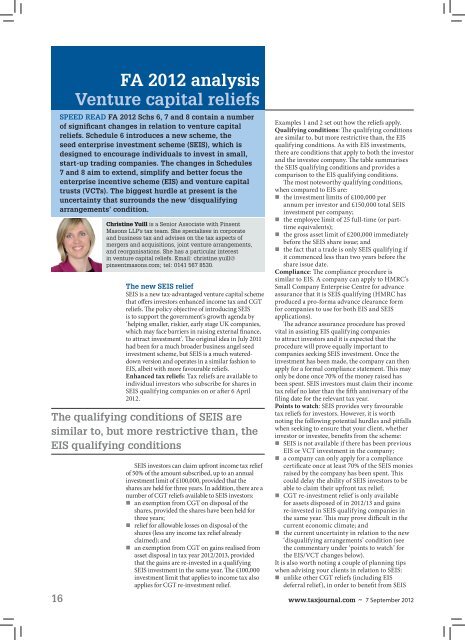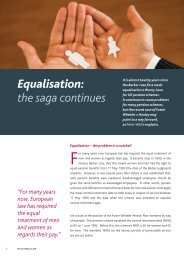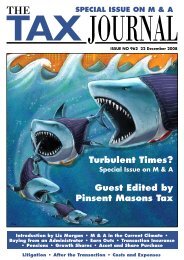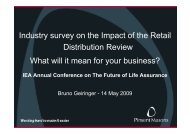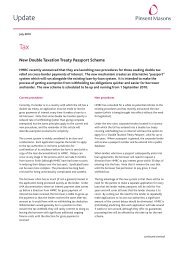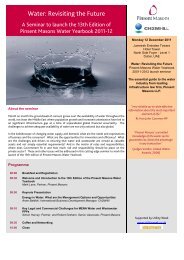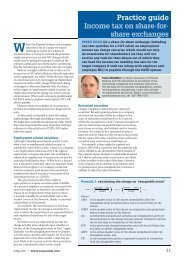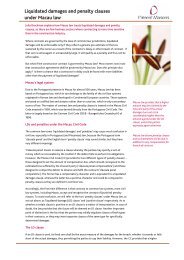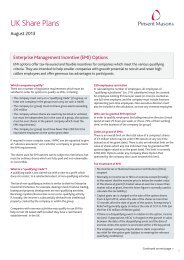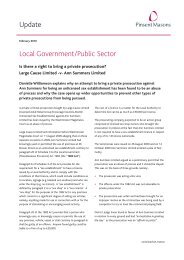Download PDF - Pinsent Masons
Download PDF - Pinsent Masons
Download PDF - Pinsent Masons
You also want an ePaper? Increase the reach of your titles
YUMPU automatically turns print PDFs into web optimized ePapers that Google loves.
FA 2012 analysis<br />
Venture capital reliefs<br />
SPEED READ FA 2012 Schs 6, 7 and 8 contain a number<br />
of significant changes in relation to venture capital<br />
reliefs. Schedule 6 introduces a new scheme, the<br />
seed enterprise investment scheme (SEIS), which is<br />
designed to encourage individuals to invest in small,<br />
start-up trading companies. The changes in Schedules<br />
7 and 8 aim to extend, simplify and better focus the<br />
enterprise incentive scheme (EIS) and venture capital<br />
trusts (VCTs). The biggest hurdle at present is the<br />
uncertainty that surrounds the new ‘disqualifying<br />
arrangements’ condition.<br />
Christine Yuill is a Senior Associate with <strong>Pinsent</strong><br />
<strong>Masons</strong> LLP's tax team. She specialises in corporate<br />
and business tax and advises on the tax aspects of<br />
mergers and acquisitions, joint venture arrangements,<br />
and reorganisations. She has a particular interest<br />
in venture capital reliefs. Email: christine.yuill@<br />
pinsentmasons.com; tel: 0141 567 8530.<br />
The new SEIS relief<br />
SEIS is a new tax-advantaged venture capital scheme<br />
that offers investors enhanced income tax and CGT<br />
reliefs. The policy objective of introducing SEIS<br />
is to support the government’s growth agenda by<br />
‘helping smaller, riskier, early stage UK companies,<br />
which may face barriers in raising external finance,<br />
to attract investment’. The original idea in July 2011<br />
had been for a much broader business angel seed<br />
investment scheme, but SEIS is a much watereddown<br />
version and operates in a similar fashion to<br />
EIS, albeit with more favourable reliefs.<br />
Enhanced tax reliefs: Tax reliefs are available to<br />
individual investors who subscribe for shares in<br />
SEIS qualifying companies on or after 6 April<br />
2012.<br />
The qualifying conditions of SEIS are<br />
similar to, but more restrictive than, the<br />
EIS qualifying conditions<br />
16<br />
SEIS investors can claim upfront income tax relief<br />
of 50% of the amount subscribed, up to an annual<br />
investment limit of £100,000, provided that the<br />
shares are held for three years. In addition, there are a<br />
number of CGT reliefs available to SEIS investors:<br />
an exemption from CGT on disposal of the<br />
shares, provided the shares have been held for<br />
three years;<br />
relief for allowable losses on disposal of the<br />
shares (less any income tax relief already<br />
claimed); and<br />
an exemption from CGT on gains realised from<br />
asset disposal in tax year 2012/2013, provided<br />
that the gains are re-invested in a qualifying<br />
SEIS investment in the same year. The £100,000<br />
investment limit that applies to income tax also<br />
applies for CGT re-investment relief.<br />
Examples 1 and 2 set out how the reliefs apply.<br />
Qualifying conditions: The qualifying conditions<br />
are similar to, but more restrictive than, the EIS<br />
qualifying conditions. As with EIS investments,<br />
there are conditions that apply to both the investor<br />
and the investee company. The table summarises<br />
the SEIS qualifying conditions and provides a<br />
comparison to the EIS qualifying conditions.<br />
The most noteworthy qualifying conditions,<br />
when compared to EIS are:<br />
the investment limits of £100,000 per<br />
annum per investor and £150,000 total SEIS<br />
investment per company;<br />
the employee limit of 25 full-time (or parttime<br />
equivalents);<br />
the gross asset limit of £200,000 immediately<br />
before the SEIS share issue; and<br />
the fact that a trade is only SEIS qualifying if<br />
it commenced less than two years before the<br />
share issue date.<br />
Compliance: The compliance procedure is<br />
similar to EIS. A company can apply to HMRC’s<br />
Small Company Enterprise Centre for advance<br />
assurance that it is SEIS qualifying (HMRC has<br />
produced a pro-forma advance clearance form<br />
for companies to use for both EIS and SEIS<br />
applications).<br />
The advance assurance procedure has proved<br />
vital in assisting EIS qualifying companies<br />
to attract investors and it is expected that the<br />
procedure will prove equally important to<br />
companies seeking SEIS investment. Once the<br />
investment has been made, the company can then<br />
apply for a formal compliance statement. This may<br />
only be done once 70% of the money raised has<br />
been spent. SEIS investors must claim their income<br />
tax relief no later than the fifth anniversary of the<br />
filing date for the relevant tax year.<br />
Points to watch: SEIS provides very favourable<br />
tax reliefs for investors. However, it is worth<br />
noting the following potential hurdles and pitfalls<br />
when seeking to ensure that your client, whether<br />
investor or investee, benefits from the scheme:<br />
SEIS is not available if there has been previous<br />
EIS or VCT investment in the company;<br />
a company can only apply for a compliance<br />
certificate once at least 70% of the SEIS monies<br />
raised by the company has been spent. This<br />
could delay the ability of SEIS investors to be<br />
able to claim their upfront tax relief;<br />
CGT re-investment relief is only available<br />
for assets disposed of in 2012/13 and gains<br />
re-invested in SEIS qualifying companies in<br />
the same year. This may prove difficult in the<br />
current economic climate; and<br />
the current uncertainty in relation to the new<br />
‘disqualifying arrangements’ condition (see<br />
the commentary under ‘points to watch’ for<br />
the EIS/VCT changes below).<br />
It is also worth noting a couple of planning tips<br />
when advising your clients in relation to SEIS:<br />
unlike other CGT reliefs (including EIS<br />
deferral relief), in order to benefit from SEIS<br />
www.taxjournal.com ~ 7 September 2012
CGT re-investment relief, only the gain (and<br />
not the full proceeds) needs to be reinvested;<br />
and<br />
EIS/VCT monies can be raised following<br />
the SEIS investment. However, EIS/VCT<br />
investment can be raised only once at least<br />
70% of the SEIS monies raised by the company<br />
has been spent.<br />
EIS and VCT changes<br />
FA 2012 makes a number of changes aimed<br />
at extending, simplifying and better focusing<br />
venture capital reliefs. While the vast majority<br />
of the changes are favourable and have been<br />
welcomed by the venture capital industry, the<br />
same cannot be said of the new ‘disqualifying<br />
arrangements’ condition which is discussed in<br />
more detail below.<br />
Increased limits and relaxation of conditions:<br />
Most of the changes result either in more<br />
companies falling within the EIS and/or VCT<br />
regime or in greater flexibility in the qualifying<br />
investments that can be made. The following<br />
changes apply to EIS and VCT investments on or<br />
after 6 April 2012:<br />
the annual EIS investment limit for individuals<br />
is doubled from £500,000 to £1m;<br />
the minimum EIS subscription of £500 is<br />
removed;<br />
the gross assets test is increased from £7m<br />
immediately before the EIS/VCT share<br />
issue and £8m immediately after to £15m<br />
immediately before and £16m immediately<br />
after;<br />
the employee limit is increased from 50 fulltime<br />
employees (or part-time equivalent)<br />
to 250 full-time employees (or part-time<br />
equivalent);<br />
the annual amount that can be invested<br />
in a company through EIS, SEIS or VCT<br />
is increased from £2m to £5m. It had been<br />
proposed in the draft legislation published<br />
in December 2011 that the limit would be<br />
increased to £10m. However, disappointingly,<br />
state aid was only granted in respect of an<br />
increase to £5m;<br />
EIS investment can be made in shares that<br />
carry certain preferential rights to dividends;<br />
and<br />
an EIS investor is no longer treated as holding<br />
a material interest in a company if he holds<br />
loan capital in the company.<br />
Feed-in tariff trades no longer qualifying: The<br />
2011 Budget announced that companies whose<br />
activities consist wholly or to a substantial<br />
extent of the subsidised generation or export<br />
of electricity (other than hydroelectric power)<br />
would cease to be EIS/VCT qualifying with effect<br />
from 6 April 2012. Finance Act 2012 makes this<br />
change, however, there are a couple of notable<br />
exceptions:<br />
where the generation or export is carried on by<br />
a community interest company, a co-operative<br />
7 September 2012 ~ www.taxjournal.com<br />
Example 1<br />
John sells an asset in August 2012 for £250,000, realising a chargeable<br />
gain of £100,000 (before exemption). Rather than paying CGT on the<br />
gain, he decides to re-invest the gain by making a qualifying SEIS<br />
investment. John subscribes £100,000 for SEIS shares which he disposes<br />
of for £150,000 in August 2016.<br />
As John has re-invested the whole of his gain and it does not exceed<br />
the annual limit of £100,000, the £100,000 gain in 2012/13 is free from<br />
CGT. John receives income tax relief of £50,000 in 2012/2013 and when<br />
he disposes of his shares in 2016/17, the £50,000 gain is CGT exempt.<br />
Example 2<br />
Rather than investing the full £100,000 gain, John re-invests £80,000 for<br />
SEIS shares. He sells the shares in August 2016 for £20,000.<br />
£80,000 of John’s 2012/13 gain is CGT exempt and the remaining<br />
£20,000 is subject to CGT (subject to any other reliefs or exemptions). He<br />
receives income tax relief in 2012/13 of £40,000. In 2016/17, he recognises<br />
a capital loss of £20,000 (loss of £60,000 less income tax relief of £40,000).<br />
Unlike other CGT reliefs (including EIS<br />
deferral relief), in order to benefit from<br />
SEIS CGT re-investment relief, only the<br />
gain (and not the full proceeds) needs to<br />
be reinvested<br />
society or a community benefit society; and<br />
where the plant used to generate the<br />
electricity relies wholly or mainly on<br />
anaerobic digestion.<br />
New ‘disqualifying arrangements’ condition:<br />
The new condition applies to all EIS, SEIS<br />
and VCT shares issued on or after 6 April<br />
2012, regardless of whether the ‘disqualifying<br />
arrangements’ occurred before or after that date.<br />
Despite the fact that the legislation relating to<br />
all three reliefs contains separate anti-avoidance<br />
provisions, the condition is an anti-avoidance<br />
test aimed at ensuring that companies are not<br />
set up for the purpose of accessing the venture<br />
capital reliefs.<br />
Arrangements are ‘disqualifying arrangements’ if:<br />
the main, or one of the main purposes, of the<br />
arrangements is to secure that the investee<br />
company carries on a ‘qualifying’ activity and<br />
that shares issued by it qualify for EIS/SEIS/VCT<br />
relief; and either:<br />
an amount representing all or the majority of<br />
the money raised under the EIS/SEIS/VCT<br />
subscription is, in the course of the arrangements,<br />
paid to or for the benefit of a person who is party<br />
to (or a connected person); or<br />
in the absence of the arrangements, it would be<br />
reasonable to expect that the greater part of the<br />
investee company’s qualifying business activities<br />
would have been carried on by a person who is<br />
For related<br />
reading, visit<br />
www.taxjournal.com:<br />
Comment:<br />
Comparing the EIS<br />
and SEIS (Annette<br />
Morley, 9.2.12)<br />
The new seed<br />
enterprise<br />
investment scheme<br />
(Clara Snow & Erika<br />
Jupe, 19.1.12)<br />
News: New EIS and<br />
VCT limits receive<br />
state aid approval<br />
(Andrew Goodall,<br />
7.6.12)<br />
Practical issues<br />
on EIS and VCT<br />
investment (Erika<br />
Jupe, 26.5.11)<br />
17
party to the arrangements (or a connected<br />
person) as part of another business.<br />
This language is very broad and, on the face of it,<br />
it appears that many investments which are not<br />
carried out for tax avoidance reasons would be<br />
caught. There is no definition of ‘arrangement’<br />
so not only is it difficult to work out what<br />
constitutes an arrangement but additionally, as<br />
a result, to work out what person or persons are<br />
party to such arrangements.<br />
The biggest hurdle at present is the<br />
uncertainty that surrounds the new<br />
‘disqualifying arrangements’ condition<br />
Points to watch: The changes to EIS and VCT<br />
in FA 2012 result in increased opportunities for<br />
both investors and companies seeking venture<br />
capital funding.<br />
The increased company and individual<br />
investment limits mean that companies can<br />
seek further EIS/VCT investment, even if<br />
they had reached the previous maximum<br />
of £2m, and that investors can reduce their<br />
income tax bill by up to £300,000 per annum<br />
rather than the previous maximum reduction<br />
of £150,000.<br />
The significant increase in the gross assets<br />
and number of employees conditions mean<br />
that many companies, which were not<br />
previously EIS and VCT qualifying, are now<br />
qualifying.<br />
There are, however, a couple of potential pitfalls<br />
and hurdles in relation to the changes:<br />
The biggest hurdle at present is the<br />
uncertainty that surrounds the new<br />
‘disqualifying arrangements’ condition.<br />
HMRC's draft guidance states that no<br />
advance assurance will be given in relation to<br />
this condition and it will only be tested once a<br />
formal application for relief is made, ie, once<br />
the shares have been issued. This uncertainty<br />
could prove a significant barrier to companies<br />
seeking venture capital investment. The<br />
guidance is draft at present and it is hoped<br />
that by the time it is finalised, HMRC will be<br />
willing to grant advance assurance which is<br />
not qualified by this condition; and<br />
While EIS investment can now be made in<br />
respect of shares carrying preferential rights<br />
to dividends, the amount and date of the<br />
dividend payments must not be dependant<br />
on a decision of the company (or any<br />
other person), and dividends must not be<br />
cumulative.<br />
<br />
Discuss the future of<br />
tax policy<br />
At the event for the business tax<br />
community<br />
www.taxjournal.com/tj/events<br />
BOOKING NOW<br />
Save £300, just £399 for Tax Journal subscribers!<br />
Email conferences@lexisnexis.co.uk quoting TJ2.<br />
18<br />
www.taxjournal.com ~ 7 September 2012
Comparing the SEIS with the revised EIS<br />
SEIS<br />
EIS<br />
Reliefs<br />
Investor limit £100,000 p.a. £1m p.a.<br />
Income tax relief 50% 30%<br />
CGT on asset sold re-invested Exempt in 2012/13 only. Deferred up to 28%.<br />
Minimum holding period Three years. Three years.<br />
Qualifying conditions for the investor<br />
Anti-avoidance<br />
No related arrangements<br />
No substantial interest (investor and<br />
associates)<br />
Employees/director<br />
Subscription for genuine commercial<br />
reasons, not for tax avoidance.<br />
No related investment arrangements.<br />
No more than 30% of:<br />
ordinary share capital;<br />
issued share capital;<br />
voting rights; or<br />
rights to assets in a winding up.<br />
Investor cannot be an employee.<br />
Investor can be a paid or unpaid director.<br />
Subscription for genuine commercial<br />
reasons, not for tax avoidance.<br />
No more than 30% of:<br />
ordinary share capital;<br />
issued share capital;<br />
voting rights; or<br />
rights to assets in a winding up.<br />
Investor cannot be an employee<br />
or director except where investor<br />
subsequently becomes a paid director.<br />
Qualifying conditions for the company<br />
Gross assets £200,000 before shares issued. £15m before EIS shares issued and £16m<br />
after.<br />
Investee company unquoted<br />
Qualifying trade<br />
Independence and control<br />
No risk capital investment<br />
Purpose of share issue<br />
Unquoted when shares issued. No<br />
arrangements to become quoted.<br />
Must exist wholly for the purpose of<br />
carrying on a qualifying trade. Trade<br />
must have commenced less than two<br />
years before shares issued.<br />
Must not be a 51% subsidiary of another<br />
company or under the control of another<br />
company.<br />
Subsidiaries must be 51% subsidiaries.<br />
No previous EIS or VCT investment.<br />
To raise money for qualifying business<br />
activity carried on by company or a 90%<br />
subsidiary.<br />
Unquoted when shares are issued. No<br />
arrangements to become quoted.<br />
Must exist wholly for the purpose of<br />
carrying on a qualifying trade.<br />
Must not be a 51% subsidiary of another<br />
company or under the control of another<br />
company.<br />
Subsidiaries must be 51% subsidiaries.<br />
To raise money for qualifying business<br />
authority carried on by company or a<br />
90% subsidiary.<br />
When money raised must be used Within three years of share issue. Within two years of share issue.<br />
UK permanent establishment UK permanent establishment. UK permanent establishment.<br />
No pre-arranged exits<br />
Number of employees (or part-time<br />
equivalent)<br />
No arrangements for cessation of trade<br />
or disposal of assets by the company.<br />
Fewer than 25. Fewer than 250.<br />
No arrangements for cessation of trade<br />
or disposal of assets by the company.<br />
Investment limit No more than £150,000 under SEIS. No more than £5m under EIS, SEIS or<br />
VCT.<br />
Company not in difficulties<br />
No disqualifying arrangements<br />
No partnerships<br />
Not in ‘financial difficulties’ when shares<br />
issued.<br />
No disqualifying arrangements in place<br />
when shares issued.<br />
Not a member of a partnership.<br />
Not be in ‘financial difficulties’ when<br />
shares are issued.<br />
No disqualifying arrangements in place<br />
when shares issued.<br />
7 September 2012 ~ www.taxjournal.com<br />
19


